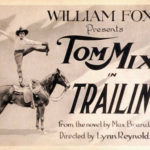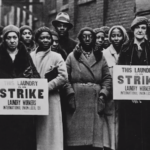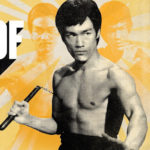Taking Aim at the Frackers
How to Adapt the Eternal Film Wisdom of Dearest Leader Kim Jong Il to Heroically Oppose the Evils of Coal-Seam-Gas Vulture Capitalism and Other Impositions of the Running Dogs of Western Imperialist Greed, at the Movies
By Peter Monaghan
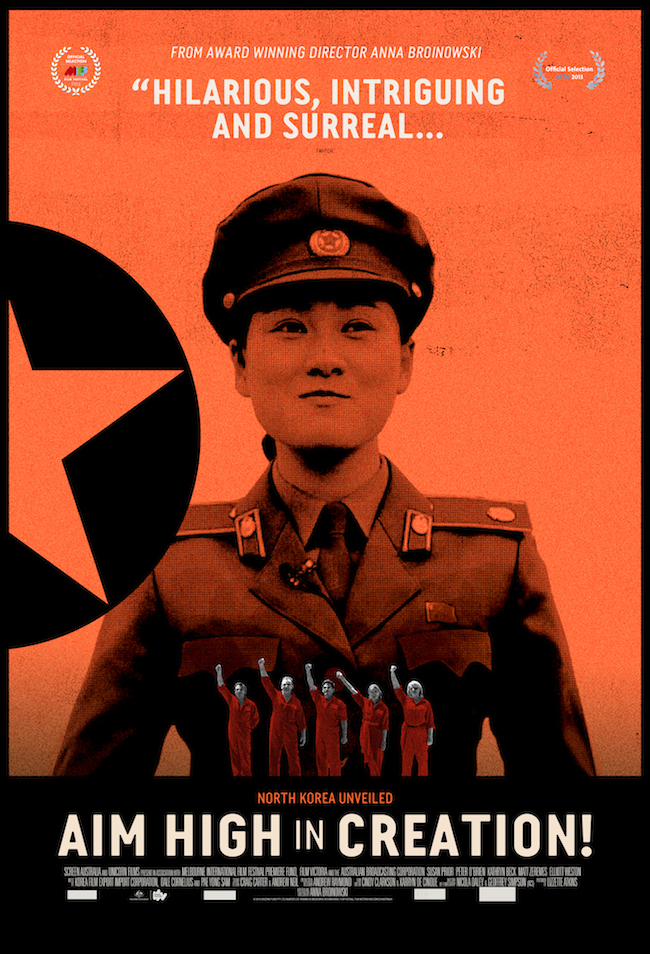
Take Anna Broinowski’s word for it: If you want to make a film to protest the placement of a coal-seam gas plant in a city park a few minutes’ walk from your home, you can supercharge your agitprop with techniques you can learn from… North Korea?
That’s where she found her inspiration for Aim High in Creation, a protest film in which she denounces inner-city gas drilling in Sydney in the style of North Korean propaganda film, and couches that within a larger presentation of the film legacy of Kim Jong Il. Not some unrecognized filmmaker so named, but that Kim Jong Il, the one who in 1994 took the reins of the singular state from his father, The Great Leader and Eternal President Kim Il Sung and made it even more cruelly oppressive and brutal before dying in 2011 and leaving a gulag nation in the hands of its latest and most deranged in a line of lunatics, Autocrat Kim #3.
A few years ago, Broinowski, a Sydney-based Australian filmmaker, joined neighbours in opposing a state-government plan to allow a gas plant in, of all places, a city park of Sydney. She writes on her film’s website: “To me, CSG [coal seam gas] is one of the most destructive examples of vulture-capitalism operating today. It is our generation’s nuclear. And it is the perfect enemy for a Kim Jong Il-style propaganda short.”

Residents of the Sydney Park area did not want their pond of calm to be made into a pit of caustic scum.
The development mirrored many others around the world – American rural and wilderness areas degraded in this way have included many in the state of Wyoming, but cities also have held up their hands. In Fort Worth, Texas, drill rigs have sprung up like clothes hoists in urban backyards within close range of billboards hollerin’ “Everybody Loves that New Rig Smell.”
What happened in Broinowski’s film career from that point sounds so improbable that you might not credit it without seeing her film. It involved a coming together of various of her curiosities and certainly a gift for pulling off striking moving-image projects.
Broinowski came to filmmaking from work as an actor, playwright, rock violinist, and journalist. She took to Japan a production of her bilingual play The Gap about an encounter between an Australian tour guide and a Japanese tourist bride at a location renowned for suicides. She wrote for Tokyo Journal, Cosmopolitan, The Sydney Morning Herald… In 1995, she was looking into Japan’s queer, bikie, and Otaku subcultures and realized that her subjects demanded visual portrayals. So she made Hell Bento, a full-length documentary that became something of a cult favourite.
More idiosyncratic directing, writing, and producing has followed, as has acclaim. Broinowski has won a variety of awards including Australia’s most desirable and a sack of others from the Aljazeera International Documentary Film Festival, the Rome Film Festival, Films des Femmes, and organizations like Moscow Film Critics and Writer’s Guild of America.
The 2007 film that preceded her North Korean ventures was Forbidden Lie$, an Australian box-office hit about a bizarre publishing hoax allegedly orchestrated by a Chicago conwoman posing as a Jordanian anti-honour-killing activist. Broinowski is alert, then, to the outré and out-of-the-way and what they can reveal about the saving or sorry states of humanity. Her riveting Helen’s War: Portrait of a Dissident, released in 2004, is about her aunt, the human-rights and peace activist Helen Caldicott; Romancing the Chakra, from 1998, is about New Age marketeering; and Sexing the Label: Love and Gender in a Queer World, 1996, addresses the labeling of sexual identities.
Broinowski’s alertness to cultures’ presumptions about others no doubt owes something to having that aunt Helen and being raised by fascinating parents in Japan, the Philippines, South Korea, Vietnam, Burma, and Iran. She was aware long before the coal-gas larceny initiative of what she calls the “vulture capitalism” of the West’s grand neoliberal project of wringing profit out of every exploitable skerrick of land or ticking human soul.
Broinowski looks to the reclusive gulag state
It was a birthday present that got her thinking about making a North Korea-style film of some kind. A friend gave her The Cinema and Directing, which was the filmmaking manifesto of Dearest Leader Kim Jong-Il, who in 1987 set out his guidelines for the craft – in the North Korean context, let’s call them “rules whose breach may result in obliteration in a city square by a mortar rocket or by incineration.”
In social formation and in film, Kim was tirelessly didactic. The self-styled “Creative Commander” visited film sets to provide “on the spot creative guidance” on 11,870 occasions, each itemized on an enormous wall chart in the Kim Jong Il film museum at the Pyongyang Film Studios.
It’s unlikely that even the most engaged film buff would be able to name a single North Korean title – unless, perhaps, Pulgasari, the Godzilla knock-off that Dearest Leader arranged to have a South Korean director come north and make (see below).
Kim II shadow-produced hundreds of films. He had caught the film bug early in life. Although his daddy dictator forbade North Koreans any access to outside culture, with dire cautions, he generously kept an eye on Western iniquity by supplying himself with movies from the West. Those provided Creative Commander-in-waiting’s schooling in film styles and craft.
Although terribly busy keeping his army and security forces and friends fed during severe famine, and running North Korea as more Kafka-meets-Grand-Guignol than Hollywood, Dearest Dictator Kim Jong Il built a vast trove of 20,000 Western films on video cassettes and housed them in a vacuum-sealed vault in a gaudy edifice. His tastes ran little to the cinema of pre-partition Korea at the dawning of film through the period of Japanese occupation (about 1905 to about 1945) and the silent era and beyond, and instead resembled those of any Western middle-class nerd of the 1990s, running from Hollywood westerns to Japanese monster movies to Hong Kong chopsocky action films to James Bond flicks — except the calumnious one that has a North Korean agent repeatedly sock our shackled hero in the goolies. He loved Friday the 13th, Rambo, and anything with Elizabeth Taylor or Sean Connery. The Cinema and Directing was just one of several film treatises those tastes inspired in him.
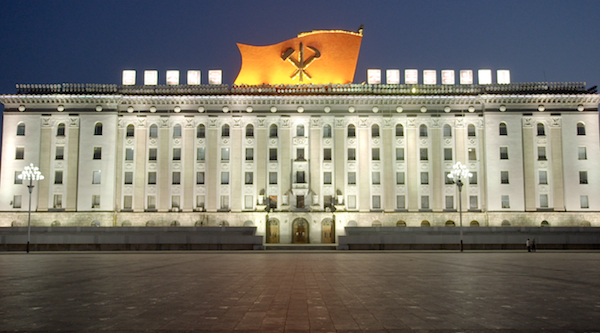
The best film archives megalomania could build
Under mad-dictatorial regimes, artists of any kind often are among the first dispatched to gulags and left there to think freely for all they like. But the propagandist in Kim II understood filmmakers as a resource for selling to the masses the notion that their country was a nirvana — the people’s choices were to believe that absurdity, appear to do so, or await the unspeakable.
Broinowski views the film scheme relatively generously. Many of the observations in Fearless Leader’s movie manifestoes sound like the self-flattering, flatulent banalities of an egomaniac who has decided he knows best what no end of people already take for granted: “The Cinema is a powerful ideological weapon.” “Best use should be made of music.” (Why films must include music at all, counter-realistically, he did not elucidate.)
The West may know the dictator best through faithful depictions of him — in tinted aviators and Mao suits, threatening to obliterate the United States — or the mocking caricatured singing-puppet pop icon in Team America and YouTube’s Kim Jong Il versus Hulk Hogan (34 million hits and counting). But Broinowski noticed something more — “a man who was passionate about cinema, and thought like an artist,” as she writes on her film’s website. Reading The Cinema and Directing “I was immediately hooked by his detailed (and often counter-intuitive) filmmaking instructions: and by the conflict between his mission to slam capitalism on screen, and his love of Western cinema.” She took to heart his exhortation to lesser film mortals: “Aim high in creation.”
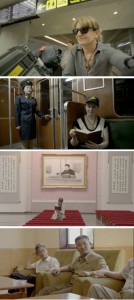
When granted rare access to the North Korean film world, Anna Broinowski at first experienced tight controls. And when she asked leading figures to teach her their propaganda methods, she met querulous looks.
So much so that she headed to North Korea to learn from his acolytes. Aided by Nicholas Bonner, a British filmmaker who has made many films about the country and leads tours there, she and a producer made a one-week reconnaissance trip, and soon afterwards she travelled there again for two and a half weeks with her director of photography, Nicola Daley. To teach her Kim Jong Il’s techniques, Pyongyang’s top directors, composers, and movie stars took her to script rehearsals, Taekwondo stunt fights, group dances, and a film shoot on the captured US “technical research ship,” USS Pueblo. She describes with pleasure an invitation from Pae Yong-sam, Dearest Filmscore Authority’s favourite composer, to hear a song he’d composed for the gas-plant-protest segment of their film. He took the visitors to a grand concert hall where a full chamber orchestra performed the piece.
Broinowski writes in press material: “Despite their almost religious belief in the Dear Leader’s cinematic genius,” directors Ri Kwan Am and Pak Jong Ju (a Kim Jong-Il fave) and other film figures she encountered “are all charming, candid, fascinating people whom I (and I hope, the audience) cannot help but like.” She says: “I was struck by their innocence and lack of cynicism” as they told anti-Soviet jokes, spoke of how their status had dropped due to a re-emphasized Songum — “military first” — policy, danced and sang, and at barbecues got as soused as running capitalist dogs are by money.
She undertook to have her film convey a sense of “filmmakers are family.” She reasoned that while Westerners may scoff at North Koreans’ gullibility, “I wanted to illustrate how we in the West are also victims of propaganda – and in doing so, stress the humanity we share with the North Koreans.”
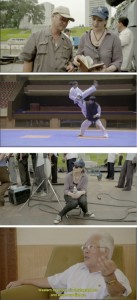 She calculated that she could do that effectively by nesting her anti-mining film-within-a-film within her portrait of North Korea’s filmmakers at work and in social settings.
She calculated that she could do that effectively by nesting her anti-mining film-within-a-film within her portrait of North Korea’s filmmakers at work and in social settings.
The protest-film segment which Geoffrey Simpson (Shine) shot on an Arri Alexa digital camera in Sydney with Australian actors and farmers are naturalistic, although of course staged in keeping with “all that is wonderful and bizarre about North Korean cinema”: whence didactic voice-overs, bold graphics, and formal interviews underscored by florid footage from the country’s film archive. In a socialist melodrama sodden with song and martial arts, “heroic workers” rise up to defeat the “capitalist swine” (we know who we are) in the form of “evil, gas-fracking miners.”
Some aspects of Aim High in Creation will remind many Western viewers of Chinese propaganda. Mao’s mighty machine of suppression, obliteration, and indoctrination produced agit-flick depictions of patriotic loyalty with titles like Taking Tiger Mountain (by Strategy). Operation Taking Tiger Mountain began with actual events but hyped to produce a legendary detachment of People’s Liberation Army freedom fighters infiltrating and destroying a cell of rebel terrorists.
That does sound familiar.
So do some North Korean feature films, as they well might given Kim Jong Il’s tutelage. As noted above, Pulgasari, the 1985 North Korean Godzilla rip-off — sure, call it “hommage” — has some profile in the West, and is on YouTube in full. As remarkable as any aspect of that production is that South Korean director Shin San Ok made it after then-dictator-in-waiting Kim Jong Il had his agents abduct him to North Korean in 1978. Earlier that year he had already similarly drafted Shin’s ex-wife, actress Choi Eun Hee.
After providing Ok with four years in prison to blue-sky projects, Ludicrous Leader Love Commander melodramatically reunited the couple at a slap-up dinner do and advised them to remarry to suit the family values of his ideal North Korean cinema. It must have been quite a moonlit soirée, because the guests agreed. A Hollywood romance!
Shin, the prolific, so-called “Prince of Korean cinema,” made seven films in Pyongyang before he and Choi, whom Deluded Leader considered his best buddies, escaped to the U.S. Embassy in Vienna while at a film festival. That outraged Host Kim. After all, he had showered the couple with largesse, providing them top-line German equipment, a matching special-effects team and some 10,000 extras for Pulgasari, and “on one occasion,” notes Broinowski, “a real train to blow up.” He denounced U.S. running dogs for kidnapping his film-lot sweethearts.
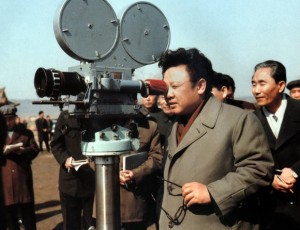 Despite Shin’s ungrateful abandonment, Jejune Impresario Jong Il’s abduction strategy paid dividends. Broinowski writes: “Shin’s movies were light on propaganda and heavy on entertainment, novelty, and sex – which had never been seen on North Korean screens before. They were hugely popular, winning a string of accolades in the Eastern Bloc, including Best Actress at Moscow International Film Festival for Shin’s wife Choi Eun Hee: for her gut-wrenching performance in the movie Sogum (“Salt”). … When Shin and Choi defected back to the West in 1986, they confirmed that Kim Jong Il was determined to make movies that could compete on the international stage.” (Shin spent the 1990s in the U.S., working under the name Simon Sheen, before risking his last years back on the Korean peninsula’s southern half.)
Despite Shin’s ungrateful abandonment, Jejune Impresario Jong Il’s abduction strategy paid dividends. Broinowski writes: “Shin’s movies were light on propaganda and heavy on entertainment, novelty, and sex – which had never been seen on North Korean screens before. They were hugely popular, winning a string of accolades in the Eastern Bloc, including Best Actress at Moscow International Film Festival for Shin’s wife Choi Eun Hee: for her gut-wrenching performance in the movie Sogum (“Salt”). … When Shin and Choi defected back to the West in 1986, they confirmed that Kim Jong Il was determined to make movies that could compete on the international stage.” (Shin spent the 1990s in the U.S., working under the name Simon Sheen, before risking his last years back on the Korean peninsula’s southern half.)
Film and the nation’s destiny
During the 1970s and 1980s, the North Korean film industry produced 30 to 40 feature films a year as well as documentaries and TV soaps including the long-running noir, Nation and Destiny. Arts Commander went to his grave in 2011 having produced more than 1,400 features and documentary films, all uncredited. Hollywood may have inspired him, but in the manifesto that set Broinowski on his path, he denounced it: “In a capitalist society the director is shackled by the government policy of commercialising the cinema, so that he is a mere worker who obeys the filmmaking industrialists whether he likes it or not. On the other hand, in the socialist society the director is an independent artist who is responsible to the people. He is Creative Commander of everything – from the film itself to the ideological life of those who take part in it.”
Broinowski says that the filmmakers she met and interviewed for Aim High in Creation “were full of genuine praise for the man they call a cinematic genius. Movie star Yun Su Gyong described his gentle approach in rehearsing actors; director Pak Jong Ju, veteran of over 40 films, said he treats Kim Jong Il’s film manifesto like a bible; Peoples’ Artist Pae Young Sam said he will never forget how Kim Jong Il taught him to write “simple songs, that are easy for the People to sing”; and cinematographer O Teh Young described the generosity of the Dear Leader: when a movie did well, filmmakers would receive gold Rolexes, apartments, and cars.”
Little wonder, then, that films apparently invariably include a propaganda speech or two about the Dear Leader or the Socialist Mission, often moving The People depicted to burst into song.
Broinowski sings along a bit, too; calling Kim Jong Il, in her website notes, “a man who loved cinema so much, you could say he was an artist who got the wrong job. He was the Eastern Bloc Spielberg: cleverly adapting the western genre films he loved to produce a smorgasbord of thrillers, action pix, rom-coms, monster movies, historical epics, and military shoot-’em-ups.” Comedies, too, and coming-of-age movies, and family dramas.
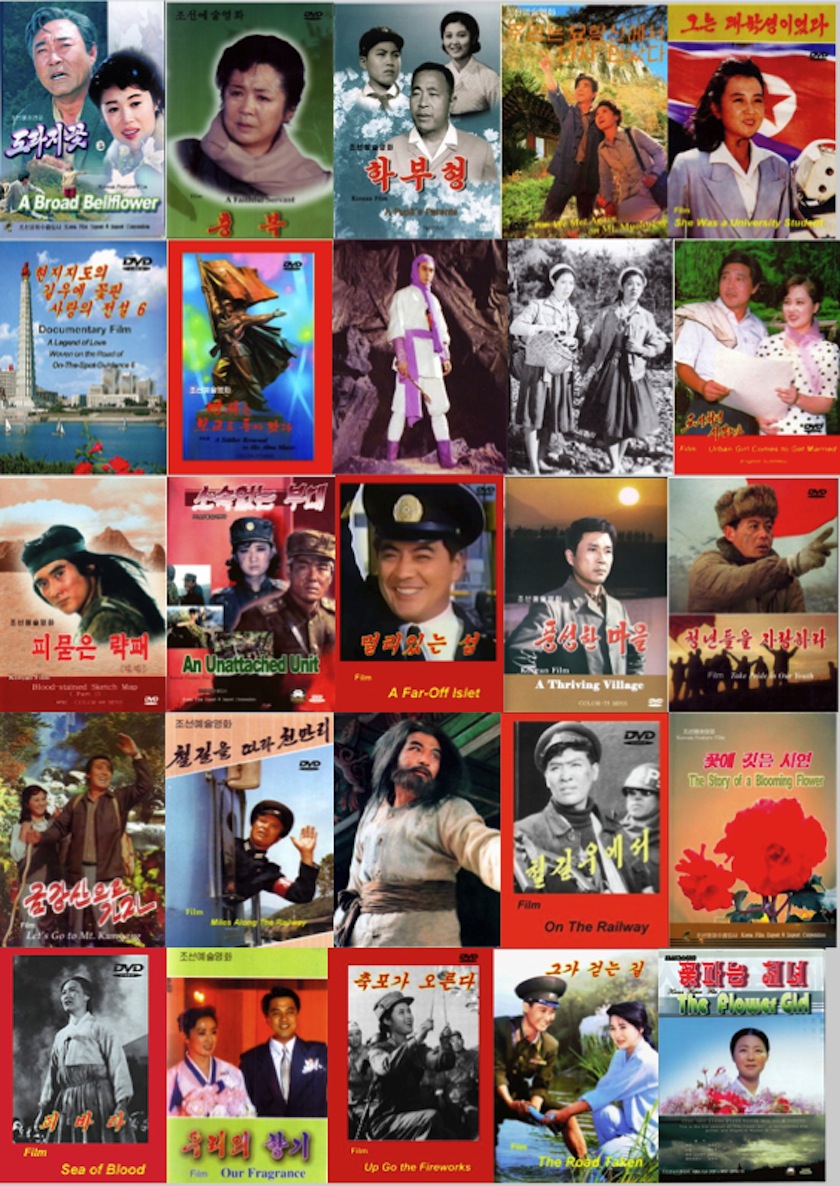
“From a western perspective,” she says, “many of Kim Jong Il’s movies look old fashioned and clunky, but the passion of their actors, the beauty of their scenery, and the diversity of their stories makes them strangely enchanting. They have a nostalgic kind of beauty, thanks to the fact that they’re still shot on celluloid with post-dubbed sound.”
She exclaims: “His films may be propaganda, but they also gave people courage, hope, certainty, novelty, beauty, and love.” You might imagine that with as many North Koreans as there are in jails, every citizen would be aware of the dangers of not professing thanks for those.
Put it another way: It seems reasonable to wonder about the nature of “art” that is steeped in, and embodies, and dictates values and ideology that are so thoroughly breached outside the cinemas that North Koreans still flock to in the absence of any vaguely free media. It’s hard to imagine that in the regime’s infamous prisons, inmates enjoy Movie Tuesdays with bulgogi and spicy popcorn as a break from life in a dank cell surviving on muddy broth and any inattentive passing vermin. It would be interesting to know how many clung to the Caring Autocrat’s sermonizing about heroic sufferance while they were among the millions who fought starvation in the prolonged, state-managed, serial famines for which the regime provided such cinematic titles as konanŭi haenggun – The March of Suffering of the 1990s. In 1993 Kim directed his starving subjects to emulate his heroism during the “Arduous March,” an official but largely concocted tale of Kim’s leading guerrilla fighters in heroic resistance to Japanese invaders. In 1995, “biblical” floods plunged the country into dire shortages that the regime’s chronic mismanagement exacerbated, as did its distributing food according to a system of perceived loyalty to the state, as did Supreme Failed Farmer’s siphoning off millions for his own political and personal purposes.
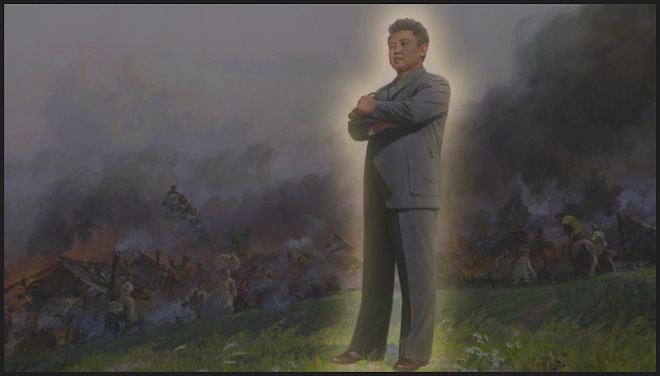
Kim Jong Il heroic poster: the dangers of directing one’s own p.r. hype.
If we can fault a large minority or eve majority of Hollywood films for manipulative insincerity, we can surely do the same for invidious pablum dressed up as entertainment or even art.
One doesn’t want to quibble. Certainly Broinowski, on the phone from Sydney, paints a picture of impressive fecundity in North Korean cinema – and these days, online searching pulls up plenty to demonstrate what she reports. She says she began to appreciate the scope of North Korean film when, during her first, week-long visit, production staff handed her 20 DVDs in unmarked sleeves she and her producer sat up in their hotel room all night watching them “because we didn’t know if they’d let us take them out.”
Her North Korean film assistants “provided me with movies that they felt were relevant to my script,” she says. “They knew that I was trying to make a film about a woman trying to stop some evil miners in a park. So, they gave me a lot of films set in nature which were quite beautiful.” One was We Met Again on Mt. Myohyang, about a beautiful mountain that Kim Jong Il has dictated that he saved from being mined for gold. Another was Bellflower from the 1980s, which Broinowski says she found “quite exquisite.” Others featured citizens strolling in the parks of Pyongyang. Others were war movies — “because I told them I was interested in battles.” Some were kitsch rom-coms, like Urban Girl Comes to Get Married, which Broinowski describes as “about an ugly duck farmer and a hoity-toity fashion designer from Pyongyang who’s too up herself. Its a star-crossed lovers film.”
Says Broinowski: “Those were my crash course.”
The DVD sampling showed her something else, too: “The fact that they could, on call, trot out 20 DVD copies of films made over a more-than-40-year period, from 1968 to 2011, would indicate that they look after their films pretty well.” Her impression was that all the holdings are on film stock: “They’re not really up on digital, yet. But they seem very efficient and organized. They must be keeping their canisters well.”
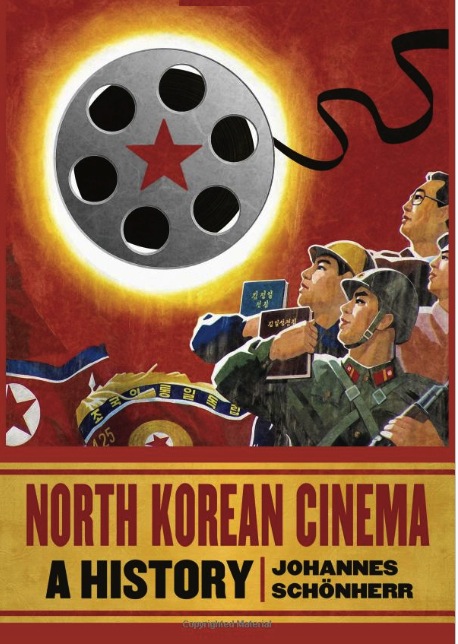 Johannes Schönherr, a free-lance writer based in Japan who writes about film, food, and travel, in 2012 published with McFarland & Company his North Korean Cinema: A History, and from the outset focuses on film as an “indispensable propaganda tool” for North Korea as for many 20th-century dictatorships. “No other medium penetrated the whole of the population so thoroughly, and no other medium remained so strictly and exclusively under state control,” he writes in his introduction. He says Kim I and Kim II both use movies in this way,”with great success.”
Johannes Schönherr, a free-lance writer based in Japan who writes about film, food, and travel, in 2012 published with McFarland & Company his North Korean Cinema: A History, and from the outset focuses on film as an “indispensable propaganda tool” for North Korea as for many 20th-century dictatorships. “No other medium penetrated the whole of the population so thoroughly, and no other medium remained so strictly and exclusively under state control,” he writes in his introduction. He says Kim I and Kim II both use movies in this way,”with great success.”
He finds scholars’ neglect of the film tradition peculiar: “Wouldn’t North Korea movies offer invaluable clues into the actual situation in the country? It would require psychologists to explain much of what they’d find, such as the right to free speech that is a right to freely mouth your way to summary execution. Artists, as much as any kinds of citizen, are expected to swallow this sort of contrariousness. Kim Jong Il has proclaimed, for example, that “the basic duty of the creative group is to make revolutionary films of high artistic value that make an effective contribution to arming the People fully within the party’s monolithic ideology, and imbue the whole of society with the great Juche idea.” Juche [“choo-chay“] is the government-mandated attitude of “self-reliance” — in a fundamentally infantilizing nation. Schönherr writes: “For an outsider, it seems curious: North Koreans may be taught from birth to see themselves as ‘independent and self-reliant,’ but they are also spectacularly good at marching, cheering, and dancing in perfect unison. I guess, from a Juche point of view, the idea is that everyone has decided, independently but at exactly the same time, to be an anonymous cog inside the same vast machine.”
In a land of mandated actions and even thoughts and emotions, no less than in Hollywood, the role of “the creative group” appears untenable, and the status of art, even entertainment, appears crippled. So, for example, the Democratic People’s Republic of Korea professes a right to free speech, and presumably its corollary right to free access to speech. Just don’t count on taking a televisual path to it. All sets are sold pre-tuned to government programming. And while reports are emerging of brave citizens watching smuggled taped South Korean programming and tuning to non-North Korean radio via Chinese-made sets, those are without doubt imperiled and unwise practices. Add to the mix similarly warped literature, newspapers, and party statements, all unopposed by virtually any outside alternatives.
Collaborations with outside filmmakers that might let in some light have been precious few, but do reveal the kinds of windows to ideology that Schönherr desires. In 1988, ever-active Italian director Ferdinando Baldi collaborated with Pyongyang colleague Pak Jong-ju (a Kim Song Il favorite director, as noted earlier) on an English-language spy film. Together they adopted the pseudonym Ted Kaplan to make Ten Zan: The Ultimate Mission, also known as Missione Finale with Western and North Korean actors and lots of explosives, a North Korean film industry specialty.
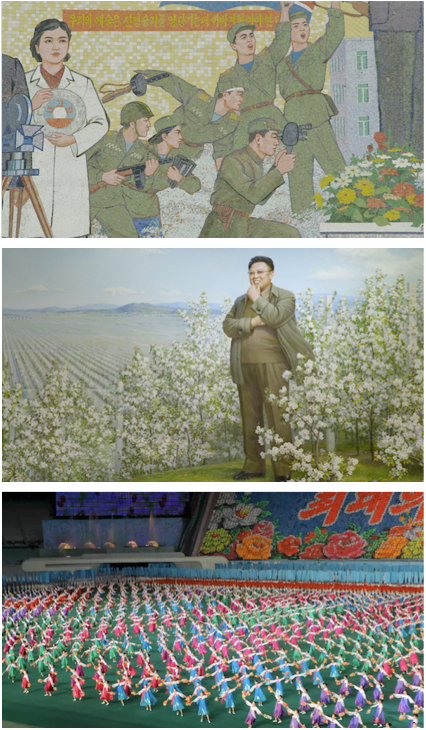
Kim Jong Il: the PR instincts of a P.T. Barnum, the soul of a dungeon executioner.
When the film showed with seven other North Korean features at the Udine Festival of Far East Film in 2000, Richard James Havis wrote in Asiaweek that it was “truly lamentable” and that “the acting is worse than that of the propaganda movies, as is the plot.”
Of course, shoot-em-up action movies that purport to constitute entertainment reveal ideologies, too. If thoughtful analyses find Hollywood examples of such fare escapist, fraudulent, and suspended at an early-teens stage of development, they could hardly find the Korean variants anything seriously inducive of “juche.”
Nowadays, any interested viewers can make their own assessments, as many of the country’s films are available via a comprehensive website of North Korean literature and film, North Korean Books, based in Winnipeg, Canada. It began business via eBay in 2001 hawking dubs of dubs of dubs of celluloid originals, its announced mission “to provide the best in hard-to-find English-language publications from North Korea.” Now more sophisticated, it offers a wide range of striking titles: A Family Bright with Songs, A Family Basketball Team, A Faithful Servant, A Letter from my Hometown, A Pupil’s Parents, A Thriving Village, Duty Of A Generation, Genuine Life Goes On, and the epically edifying A Legend of Love Woven on the Road of On-The-Spot-Guidance.
Among more soul-searching selections are the reassuring Sixty is the Prime of Life, the cautionary Story of a Party Worker, the exhortative Take Pride in our Youth, the frankly confrontative How Are You?, the elegiac and exemplary She Was a University Student in a land without orgiastic spring breaks or schoolies weeks, 13 series of The Nation and Destiny, Mother’s Happiness, presumably a fantasy along with People With Freedom of Religion, and the incendiary Up Go The Fireworks. Not to mention the peerless General Kim Jong Il’s Matchless Patriotic Defense of the Country.
A trio of releases comprise the Careful He Might Hear You of North Korean cinema: The Problem of Our Downstairs Neighbour, The Problem of Our Upstairs Neighbour, and The Problem of Our Next Door Neighbour. And from there you may move on to the curdling Sea of Blood also available in song as Sea of Blood Revolutionary Opera.
You want romance, there’s Urban Girl Comes to Get Married and the pregnant-with-romance Salesgirls on a Train and The Girl We Met on Our Trip. Lorn love? Try A Traffic Controller at a Crossroads.
Among bucolic options are A Forest is Swaying, The Story of a Blooming Flower, and Song of Introspection.
Get your Paths of Glory kicks with An Unattached Unit, A Soldier Returned to his Alma Mater, Bloodstained Sketch Map, Brigade’s Political Commissar, Five Guerrilla Brothers, Love the Soldiers, Miss Ha and General Jim, Quiet Front Line.
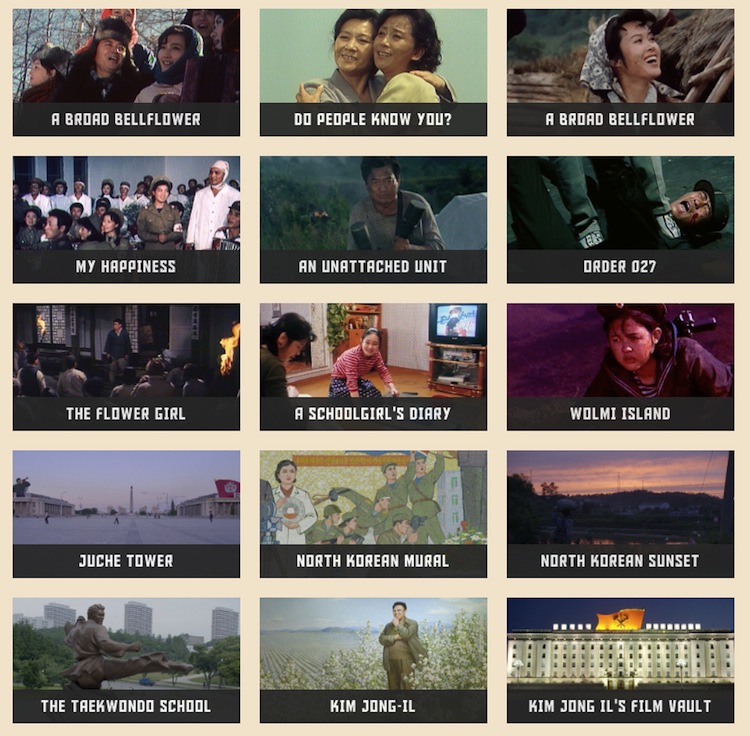 Celebrate the mass-murdering, critic-torturing honorable leaders with Kim Jong Il Gives Field Guidance to the Construction in the Area of Mt. Paektu, or Mass Performance 55th Anniversary of the Founding of the Workers’ Party of Korea.
Celebrate the mass-murdering, critic-torturing honorable leaders with Kim Jong Il Gives Field Guidance to the Construction in the Area of Mt. Paektu, or Mass Performance 55th Anniversary of the Founding of the Workers’ Party of Korea.
In case you don’t know what to think, or weep at, during visits to the Propaganda Empire, there are titles like Beauty is Added to the Country Under the Great General’s Leadership, Forever with Kim Jong Il, Fatherland Liberation War, and Respected Leader Kim Jong Il is a Great Thinker and Theoretician.
Don’t forget celebrations of the country’s victories over oppressors: U.S.S. Pueblo Archival Video Clips, and Inerasable Crimes of Japan…
If you want irony: look elsewhere.
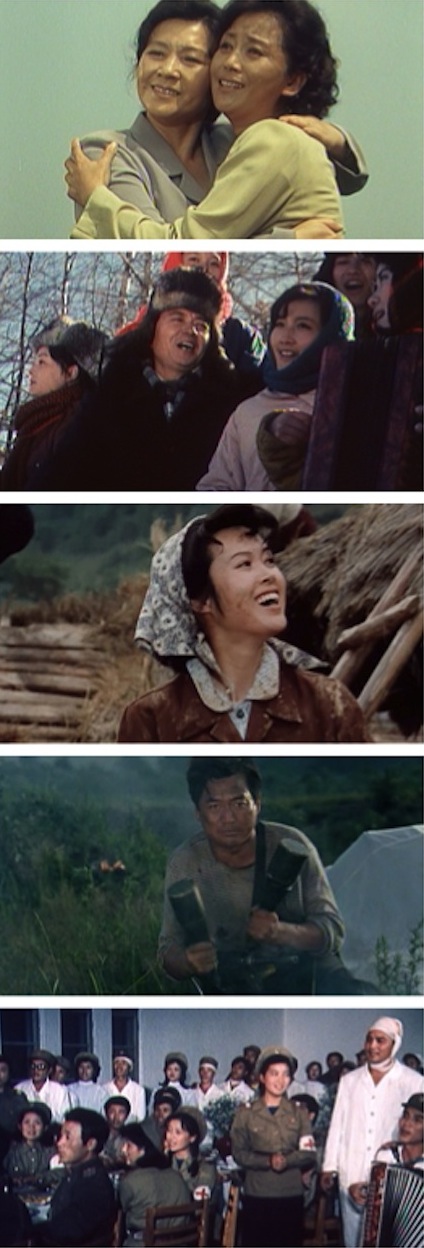 Another source of film information and sales is a government sales and film-studio company called Korfilm. Says Broinowski: “To the extent North Korea does Western things like copyright, they seem to own the rights to distribute the films, because they’re the ones we had to pay an archive fee to in order to use in my film excerpts from the films they gave us.”
Another source of film information and sales is a government sales and film-studio company called Korfilm. Says Broinowski: “To the extent North Korea does Western things like copyright, they seem to own the rights to distribute the films, because they’re the ones we had to pay an archive fee to in order to use in my film excerpts from the films they gave us.”
From Korfilm and North Korean Books – and increasingly through various online sources – you can obtain a sense of what has battered North Korean brains since the Kim regime took power in 1948 and survived beyond its invasion of South Korea, which triggered the Korean War of 1950-53.
Schönherr writes that film, more than any medium, constituted the regime’s myth-building indoctrination of the populace: Movies and documentaries established that the North won the conflict through the way they insistently “sang the praises of the Northern army in its pitched battles against those of the South and the great demon United States, which were cast as the initiators of every single woe occurring in North Korea.” Among the regime’s methods of enforcing its preferred version of reality: Films were made that targeted “all behavior considered ‘impure,’ ‘old-fashioned,’ or ‘foreign-influenced’.”
When the cinephile Kim Jong Il took over from Eternal albeit mortally dead dad, film became far more crucial in the indoctrination campaign. Writes Schönherr: “By producing grand dramas promoting the myth that his father was the true and sole liberator of Korea, he could prove his absolute loyalty.”
Come Friday evening, a Korean family could soak up yet another tale of one Kim regime member or another saving the country singlehanded, but was likely to have to grin and bear the deranged fare because, says Schönherr, while Cinema Master Kim “wanted international recognition for his films and to develop North Korea into a cinema powerhouse,” under his patronage “the overall quality of North Korean cinema remained lacking. The ideological restrictions suffocated creativity and the isolation of the country blocked new ideas from entering.”
Again, why should Pyongyang differ categorically from, say, Hollywood? In effect, it seems safe to say, to be a North Korean filmgoer meant being well inclined to suppress one’s skepticism.
With all the unreality and megalomania in the Kims’ Korean film world, would filmmakers not somehow find ways to signal disdain for their rulers and comprehensive censors?
Broinowski thinks not: “I looked really carefully, but I could not see any example of signaling or subversion of any kind in any of these movies, which astounded me because I was so aware of what Soviet artists were up to just before the Wall came down. All art operated on two levels – it passed the censors, but it also told the people a very different message.
The North Korean films differ, she says: “They weren’t all wall-to-wall propaganda – some were delicate comedies about married life or romantic stories. They certainly deviate from the message which is ‘We live in a great country and the leaders are great.'” At most, she saw that 1980s films were less heavy-handed in their slathers of propaganda but instead more “kitsch and crazy,” but by the 1990s, Kim Jong Il saw fit to blare out the glories and might of his military and nation.
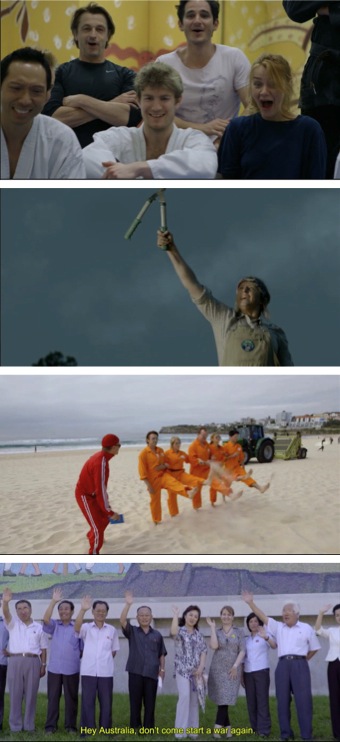
Broinowski’s Sydneysiders marvel at the way North Korean film actors learn to kiss arse; practice some essential skills of the Kim Jong Il manifesto; and are greeted via video hookup by their Pyongyang peers.
Whether you’ll agree with Anna Broinowski that, regardless of the absurd portrayal within North Korea of Kim Jong Il as everything heroic, his aptitude for film was extraordinary or extraordinarily hyped, there are at least now opportunities to gauge — not always via the North Korean sources, but YouTube has compelling portraits like Jang In Hak and An Jun Bo’s The Schoolgirl’s Diary.
Meanwhile her and others’ fight against coal-seam gas continues. It will need to continue for decades in Australia and everywhere else if it is to solidify recent gains in public and even regulatory support. In Sydney, those followed protesters’ successfully bringing into plain sight the slyness with which state leaders had sought to slip permits to gas companies.
What of the dictator-as-cinéaste mythos that the Kim regime attached to itself? Kim Jong Il’s successor earned a reputation while at his decidedly unsocialist-revolutionary Swiss boarding school for dullness and apparently expressed no inclination towards film. Nor then, nor since — not towards anything arts related, nor for that matter towards anything unrelated to the brainstem thuggery of a Hollywood-style goon.
Some major studio in the L.A. area might think of knocking out a Chuck Norris/Rambo/John Wayne-as-lughead action blockbuster about Baby Kim’s being kidnapped and force-fed common sense at a Swiss finishing school. Already, somehow or other, Nicholas Bonner, the filmmaker who gave Broinowski her entrée to Pyongyang, has made feature films in the country that dispense with Kim Jong Il specs. If the filmmakers Broinowski portrays ever get that opportunity, they will have a surprising and impressive history to build on.
Planning to go see for yourself? Get the North Korea Travel App for iPhone and Android. Or contact Nicholas Bonner’s Koryo Tours.
Previous Post: The U.S. Library of Congress, from the Inside
Next Post: The War Films of Indiana

